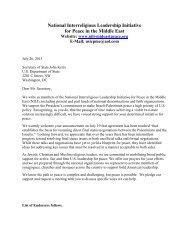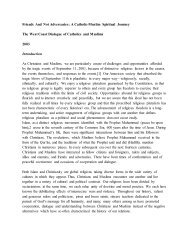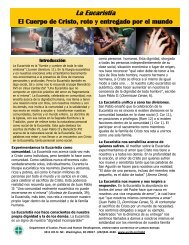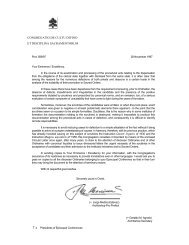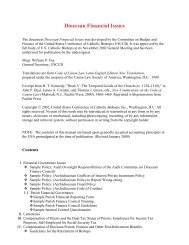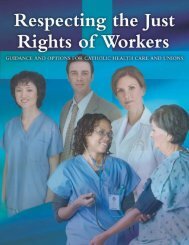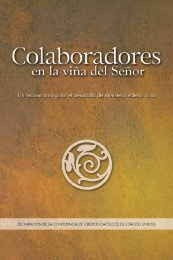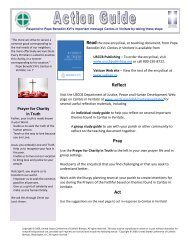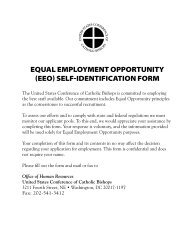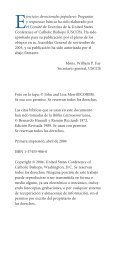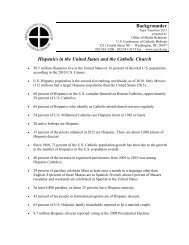Doctrinal Elements of a Curriculum Framework for the Development ...
Doctrinal Elements of a Curriculum Framework for the Development ...
Doctrinal Elements of a Curriculum Framework for the Development ...
- No tags were found...
Create successful ePaper yourself
Turn your PDF publications into a flip-book with our unique Google optimized e-Paper software.
whole Deposit <strong>of</strong> Faith, that is, <strong>the</strong> Revelationpreserved in Scripture and in Tradition (CCC, nos.84,863-865, 1202).II. Christian Churches and EcclesialCommunities Apart from <strong>the</strong>Catholic ChurchA. An ecclesiology <strong>of</strong> communion (CCC, nos. 787-789).1. Baptized people are in full communion with <strong>the</strong>Catholic Church when <strong>the</strong>y are joined with Christin <strong>the</strong> visible structure <strong>of</strong> <strong>the</strong> Church through <strong>the</strong>pr<strong>of</strong>ession <strong>of</strong> faith, <strong>the</strong> reception <strong>of</strong> <strong>the</strong> sacraments,and respect and obedience toward those inauthority in <strong>the</strong> Church (CIC, c. 205).2. Members <strong>of</strong> o<strong>the</strong>r Christian churches and ecclesialcommunities are in imperfect communion with <strong>the</strong>Catholic Church (CCC, nos. 836-838).a. The communion is imperfect because <strong>of</strong>differences in doctrine, discipline, and/orecclesiastical structure.b. Christian churches (Orthodox Churches) arethose with a validly ordained priesthood and<strong>the</strong> Eucharist (CCC, nos. 838).c. Christian ecclesial communities do not have avalidly ordained priesthood or <strong>the</strong> Eucharist.3. The ecumenical movement works to overcomeobstacles to full communion.4. All <strong>the</strong> baptized, including those in imperfectcommunion with <strong>the</strong> Catholic Church, aremembers <strong>of</strong> Christ’s Body, have <strong>the</strong> right to becalled Christian, and are bro<strong>the</strong>rs and sisters tomembers <strong>of</strong> <strong>the</strong> Catholic Church (UR, no. 3).B. From <strong>the</strong> very beginning <strong>of</strong> <strong>the</strong> Church, <strong>the</strong>re havebeen rifts and serious dissension (CCC, no. 817).Serious dissensions resulted in breaks from fullcommunion with <strong>the</strong> Church.1. Schism with some Eastern Churches.a. Following <strong>the</strong> Council <strong>of</strong> Ephesus in 431.1) Because <strong>of</strong> a dispute over <strong>the</strong> title <strong>of</strong> Maryas Mo<strong>the</strong>r <strong>of</strong> God, some Churches, such as<strong>the</strong> Assyrian Church, broke away fromfull communion.2) Later some returned to union with Rome.3) Modern dialogue with those who didnot return has made progress in healingthis schism.b. Following <strong>the</strong> Council <strong>of</strong> Chalcedon in 451.1) Those who believed <strong>the</strong> Monophysiteheresy (that Jesus did not have both adivine nature and a human nature) alsobroke away from full communion with <strong>the</strong>Church and <strong>for</strong>med what are called <strong>the</strong>Oriental Orthodox Churches.2) Modern dialogue with <strong>the</strong> OrientalOrthodox Catholics has made progress inhealing this schism.2. The Catholic Church and <strong>the</strong> Eastern OrthodoxChurch were one until 1054.a. The Schism <strong>of</strong> 1054 resulted in <strong>the</strong> establishment<strong>of</strong> <strong>the</strong> Eastern Orthodox Churches.b. Contributing causes to <strong>the</strong> Schism <strong>of</strong> 1054.1) Filioque controversy (CCC, nos. 247-248).2) Growing cultural and political differencesbetween East and West.3) Different <strong>for</strong>ms <strong>of</strong> Church governanceemerged.a) Eastern Churches were governed bysynods with a patriarch.b) Latin Church was monarchical with<strong>the</strong> pope as final authority.c. Difference between Orthodox Churches andEastern Catholic Churches.1) They share <strong>the</strong> same liturgy but not <strong>the</strong>same bonds <strong>of</strong> episcopal communion.d. Orthodox Churches and Catholic Churchhave strong ties to each o<strong>the</strong>r.1) Same core doctrine, beliefs, and moralteachings.2) Both have Apostolic Succession.3) Seven sacraments, validity <strong>of</strong> ordinations.e. Differences between <strong>the</strong> Catholic Church andEastern Orthodox Churches.1) Most significant: Orthodox Churchesdo not recognize <strong>the</strong> infallibility or <strong>the</strong>primacy <strong>of</strong> jurisdiction <strong>of</strong> <strong>the</strong> Pope.2) A few doctrinal <strong>for</strong>mulations in <strong>the</strong>liturgy: <strong>the</strong> Eastern Orthodox Churchesuse <strong>the</strong> original wording <strong>of</strong> <strong>the</strong> NiceneCreed and do not accept <strong>the</strong> addition <strong>of</strong><strong>the</strong> filioque (<strong>the</strong> Holy Spirit proceeds from<strong>the</strong> Fa<strong>the</strong>r and <strong>the</strong> Son).3) Differences in sacramental law andpractice (e.g., Orthodox tolerate divorceand remarriage).4) Some Marian dogmas are taught in adifferent way.5) Ecumenical councils: not all accepted by<strong>the</strong> Orthodox Churches.3. Ecclesial communions: Anglican (Episcopalian),Lu<strong>the</strong>ran, Re<strong>for</strong>med Christian.a. Who founded <strong>the</strong>se various ecclesialcommunities and why?50<strong>Doctrinal</strong> <strong>Elements</strong> <strong>of</strong> a <strong>Curriculum</strong> <strong>Framework</strong> <strong>for</strong> <strong>the</strong><strong>Development</strong> <strong>of</strong> Catechetical Materials <strong>for</strong> Young People <strong>of</strong> High School Age



